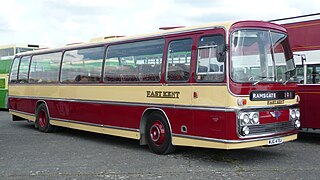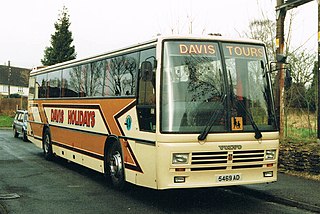Plaxton is an English builder of bus and coach vehicle bodies based in Scarborough. Founded in 1907 by Frederick William Plaxton, it became a subsidiary of Alexander Dennis in May 2007. In 2019, the maker was acquired by Canadian bus manufacturer New Flyer which then became NFI Group.

The Dennis Dart is a rear-engined single-decker midibus chassis that was introduced by Dennis Specialist Vehicles of Guildford, England in 1989, replacing the Dennis Domino. Initially built as a high-floor design, in 1996 the low-floor second generation Dennis Dart SLF was launched. In 2001, production of the Dart SLF passed to TransBus International, during which time it was sold as the TransBus Dart SLF; Alexander Dennis took over production in 2004, renaming the product as the Alexander Dennis Dart SLF.

The Volvo B7TL is a low-floor double-decker bus chassis which was launched in 1999 and replaced the 2-axle version of the Volvo Olympian. It was built as the British bus operators seemed hesitant to purchase the B7L double decker with a long rear overhang.

Duple Coachbuilders was a coach and bus bodybuilder in England from 1919 until 1989.

The Leyland Leopard was a mid-engined single-decker bus and single-decker coach chassis manufactured by Leyland between 1959 and 1982.

The Leyland Tiger, also known as the B43, was a mid-engined bus and coach chassis manufactured by Leyland between 1981 and 1992. This name had previously been used for a front-engined bus built between 1927 and 1968. It replaced the Leyland Leopard, which had been in production for over 20 years.

Barton Transport was a bus company that operated in Nottinghamshire from 1908 until 1989.

The Plaxton Panorama Elite was a successful design of coach bodywork built between 1968 and 1975 by Plaxton of Scarborough, Yorkshire, England. A wide-doorway variant called the Plaxton Elite Express was also built. Collectively, they are commonly referred to as the Plaxton Elite.

The Plaxton Supreme was a design of coach bodywork built by Plaxton. It was first built, on small chassis only, in 1974, replacing the Plaxton Panorama. On full-sized chassis, it replaced the Panorama Elite in 1975, and was superseded by the Paramount in 1982/3. However, the Supreme continued to be built on the small Bedford VAS chassis until 1986.

The Plaxton Paramount was a design of coach bodywork built by Plaxton. It first appeared at the 1982 British Motor Show and was built until 1992.

The Plaxton Premiere, Plaxton Excalibur and Plaxton Prima were closely related designs of coach bodywork built by Plaxton.

The Duple Dominant was a design of a coach bodywork built by Duple between 1972 and 1987. It introduced an all-steel structure and replaced the wooden-framed Duple Vega, Viceroy and Vista models.

The Northern Counties Paladin, also badged as the Plaxton Paladin towards the end of production, is a step-entrance single-decker bus body built by Northern Counties of Wigan, UK, between 1991 and 1998. The replacements for the Paladin are the Prestige and the Pointer as low-floor models for the Paladin LF.

The Bedford VAL is a type of coach chassis that was built by Bedford in the United Kingdom from the mid-1960s to the early 1970s. It was unusual at the time for its multi-axle design, in a "chinese six" wheelplan, i.e. with two front steering axles.

The Leyland Royal Tiger was a rear-engined coach chassis manufactured by Leyland between 1982 and 1987. It was intended to counter the offerings of foreign competitors such as the Jonckheere or Van Hool bodied DAF, Scania and Volvo touring coaches, but was not particularly successful, with only between 160 and 170 built.
The Seddon Pennine RU was a rear-engined single-decker bus built by Seddon Diesel Vehicles/Seddon Atkinson between 1969 and 1974.

The Seddon Pennine 7 was a mid-underfloor-engined single-deck bus or coach chassis built by Seddon Atkinson between 1974 and 1982.

The Leyland Royal Tiger Worldmaster, sometimes simply known as the Leyland Worldmaster, was a mid-underfloor-engined single-decker bus or single-decker coach chassis manufactured by Leyland between 1954 and 1979.

The Bristol LH was a single-decker bus chassis built by Bristol Commercial Vehicles (BCV) in Bristol, England. Nearly 2,000 were built between 1967 and 1982 in a variety of sizes and body types, including some as goods vehicles.

The Duple 300 Series were a range of bus and coach bodywork built by Duple between 1985 and 1989. The range comprised the 3,000 mm high Duple 300 service bus, the 3,200 mm high Duple 320 coach, and the taller 3,400 mm high Duple 340 coach. The 320 and 340 coaches were announced at the Bus and Coach Show at Earls Court in September 1985 as replacements for the previous Laser and Caribbean. Deliveries of these models commenced in 1986, whilst the 300 bus was launched in 1987 as a replacement for the Dominant Bus. After Duple closed down the designs were sold to Plaxton and a small number of additional 320 bodies were built as the Plaxton 321.

















